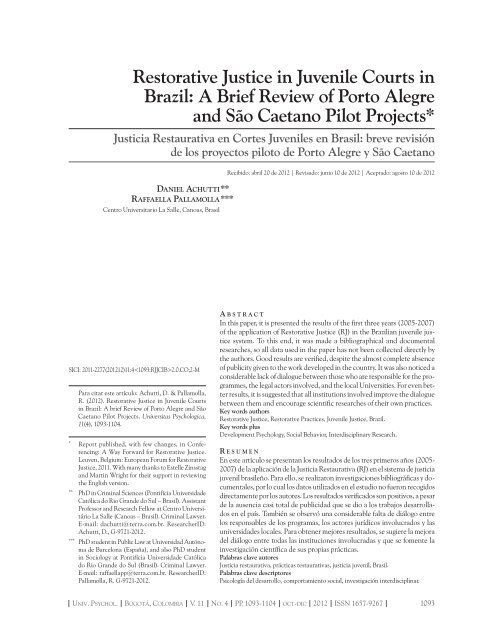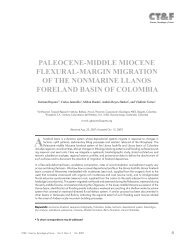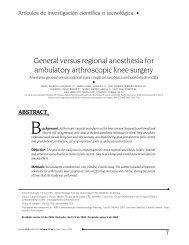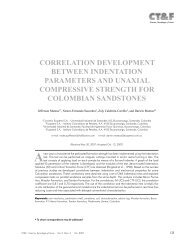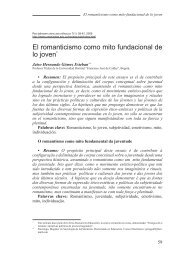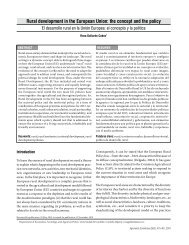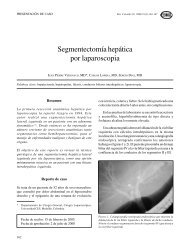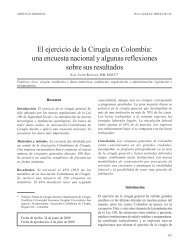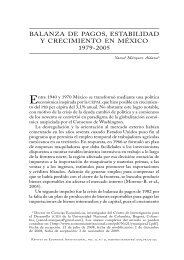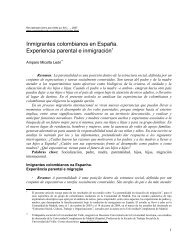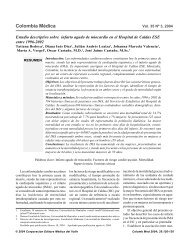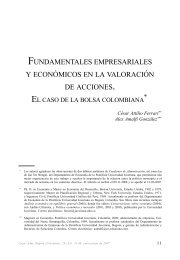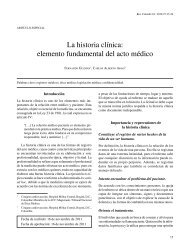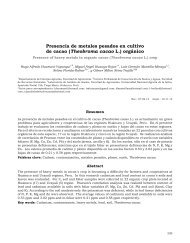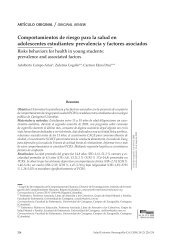Restorative Justice in Juvenile Courts in Brazil ... - Revista Javeriana
Restorative Justice in Juvenile Courts in Brazil ... - Revista Javeriana
Restorative Justice in Juvenile Courts in Brazil ... - Revista Javeriana
Create successful ePaper yourself
Turn your PDF publications into a flip-book with our unique Google optimized e-Paper software.
<strong>Restorative</strong> <strong>Justice</strong> <strong>in</strong> <strong>Juvenile</strong> <strong>Courts</strong> <strong>in</strong><br />
<strong>Brazil</strong>: A Brief Review of Porto Alegre<br />
and São Caetano Pilot Projects*<br />
Justicia Restaurativa en Cortes <strong>Juvenile</strong>s en Brasil: breve revisión<br />
de los proyectos piloto de Porto Alegre y São Caetano<br />
Daniel Achutti **<br />
Raffaella Pallamolla ***<br />
Centro Universitario La Salle, Canoas, Brasil<br />
Recibido: abril 20 de 2012 | Revisado: junio 10 de 2012 | Aceptado: agosto 10 de 2012<br />
SICI: 2011-2277(201212)11:42.0.CO;2-M<br />
Para citar este artículo: Achutti, D. & Pallamolla,<br />
R. (2012). <strong>Restorative</strong> <strong>Justice</strong> <strong>in</strong> <strong>Juvenile</strong> <strong>Courts</strong><br />
<strong>in</strong> <strong>Brazil</strong>: A brief Review of Porto Alegre and São<br />
Caetano Pilot Projects. Universitas Psychologica,<br />
11(4), 1093-1104.<br />
*<br />
Report published, with few changes, <strong>in</strong> Conferenc<strong>in</strong>g:<br />
A Way Forward for <strong>Restorative</strong> <strong>Justice</strong>.<br />
Leuven, Belgium: European Forum for <strong>Restorative</strong><br />
<strong>Justice</strong>, 2011. With many thanks to Estelle Z<strong>in</strong>sstag<br />
and Mart<strong>in</strong> Wright for their support <strong>in</strong> review<strong>in</strong>g<br />
the English version.<br />
**<br />
PhD <strong>in</strong> Crim<strong>in</strong>al Sciences (Pontifícia Universidade<br />
Católica do Rio Grande do Sul – Brasil). Assistant<br />
Professor and Research Fellow at Centro Universitário<br />
La Salle (Canoas – Brasil). Crim<strong>in</strong>al Lawyer.<br />
E-mail: dachutti@terra.com.br. ResearcherID:<br />
Achutti, D., G-9721-2012.<br />
***<br />
PhD student <strong>in</strong> Public Law at Universidad Autónoma<br />
de Barcelona (España), and also PhD student<br />
<strong>in</strong> Sociology at Pontifícia Universidade Católica<br />
do Rio Grande do Sul (Brasil). Crim<strong>in</strong>al Lawyer.<br />
E-mail: raffaellapp@terra.com.br. ResearcherID:<br />
Pallamolla, R. G-9721-2012.<br />
A b s t r a c t<br />
In this paper, it is presented the results of the first three years (2005-2007)<br />
of the application of <strong>Restorative</strong> <strong>Justice</strong> (RJ) <strong>in</strong> the <strong>Brazil</strong>ian juvenile justice<br />
system. To this end, it was made a bibliographical and documental<br />
researches, so all data used <strong>in</strong> the paper has not been collected directly by<br />
the authors. Good results are verified, despite the almost complete absence<br />
of publicity given to the work developed <strong>in</strong> the country. It was also noticed a<br />
considerable lack of dialogue between those who are responsible for the programmes,<br />
the legal actors <strong>in</strong>volved, and the local Universities. For even better<br />
results, it is suggested that all <strong>in</strong>stitutions <strong>in</strong>volved improve the dialogue<br />
between them and encourage scientific researches of their own practices.<br />
Key words authors<br />
<strong>Restorative</strong> <strong>Justice</strong>, <strong>Restorative</strong> Practices, <strong>Juvenile</strong> <strong>Justice</strong>, <strong>Brazil</strong>.<br />
Key words plus<br />
Development Psychology, Social Behavior, Interdiscipl<strong>in</strong>ary Research.<br />
R e s u m e n<br />
En este artículo se presentan los resultados de los tres primeros años (2005-<br />
2007) de la aplicación de la Justicia Restaurativa (RJ) en el sistema de justicia<br />
juvenil brasileño. Para ello, se realizaron <strong>in</strong>vestigaciones bibliográficas y documentales,<br />
por lo cual los datos utilizados en el estudio no fueron recogidos<br />
directamente por los autores. Los resultados verificados son positivos, a pesar<br />
de la ausencia casi total de publicidad que se dio a los trabajos desarrollados<br />
en el país. También se observó una considerable falta de diálogo entre<br />
los responsables de los programas, los actores jurídicos <strong>in</strong>volucrados y las<br />
universidades locales. Para obtener mejores resultados, se sugiere la mejora<br />
del diálogo entre todas las <strong>in</strong>stituciones <strong>in</strong>volucradas y que se fomente la<br />
<strong>in</strong>vestigación científica de sus propias prácticas.<br />
Palabras clave autores<br />
Justicia restaurativa, prácticas restaurativas, justicia juvenil, Brasil.<br />
Palabras clave descriptores<br />
Psicología del desarrollo, comportamiento social, <strong>in</strong>vestigación <strong>in</strong>terdiscipl<strong>in</strong>ar.<br />
Univ. Psychol. Bogotá, Colombia V. 11 No. 4 PP. 1093-1104 oct-dic 2012 ISSN 1657-9267 1093
Daniel Achutti, Raffaella Pallamolla<br />
Introduction<br />
<strong>Restorative</strong> <strong>Justice</strong> <strong>in</strong> <strong>Brazil</strong><br />
<strong>Restorative</strong> <strong>Justice</strong> 1 (RJ) has recently started emerg<strong>in</strong>g<br />
as an alternative approach to deal<strong>in</strong>g with<br />
crim<strong>in</strong>ality 2 <strong>in</strong> <strong>Brazil</strong>. This comes as a direct consequence<br />
of the lack of social legitimacy of the<br />
<strong>Brazil</strong>ian crim<strong>in</strong>al justice system and its <strong>in</strong>capacity<br />
and <strong>in</strong>efficiency to manage social conflicts. These<br />
reasons, added to the <strong>in</strong>creas<strong>in</strong>g social violence and<br />
a constant non-observance of civil rights by the<br />
State, require an <strong>in</strong>tensive search for alternatives<br />
to the traditional crim<strong>in</strong>al justice system 3 .<br />
Currently, there is no legal support for RJ <strong>in</strong><br />
<strong>Brazil</strong>, both <strong>in</strong> adult and juvenile courts. However,<br />
there is a draft law (No. 7006/2006) <strong>in</strong> the National<br />
Parliament, which plans to <strong>in</strong>troduce RJ <strong>in</strong>to the<br />
Penal Code and the Code of Crim<strong>in</strong>al Procedure,<br />
as well as <strong>in</strong> the Law of the Special <strong>Courts</strong> (law<br />
No. 9099/1995).<br />
Despite the absence of a legal base, restorative<br />
justice is be<strong>in</strong>g applied s<strong>in</strong>ce 2005 <strong>in</strong> some cities<br />
across <strong>Brazil</strong>. The first pilot projects began <strong>in</strong> Porto<br />
Alegre (Rio Grande do Sul State), São Caetano do<br />
Sul (São Paulo State), and Brasilia (Federal District),<br />
with fund<strong>in</strong>g from the <strong>Brazil</strong>ian M<strong>in</strong>istry<br />
of <strong>Justice</strong> and its Secretariat for the Reform of the<br />
Judiciary, and also from the United Nations Development<br />
Programme (UNDP). The project was<br />
1 Despite the considerable difficulties on the def<strong>in</strong>ition of restorative<br />
justice, there is a relative consensus on the concept proposed<br />
by Tony Marshall (see, for example, Braithwaite, 2002; Strang,<br />
2002; Shapland et al., 2006; Walgrave, 2008; Pallamolla, 2009;<br />
Hoyle, 2010; Ruggiero, 2011; etc.), for whom restorative justice<br />
can be def<strong>in</strong>ed as “a process whereby all the parties with a stake<br />
<strong>in</strong> a particular offence come together to resolve collectively how<br />
to deal with the aftermath of the offence and its implications for<br />
the future” (Marshall, 1996, p. 37.) For critical considerations on<br />
this def<strong>in</strong>ition, see Braithwaite (2002) and Walgrave (2008).<br />
2 For the words ‘crim<strong>in</strong>ality’ and ‘crime’ <strong>in</strong> Portuguese, we also use<br />
‘conflict’, therefore all three words will be used <strong>in</strong>terchangeably<br />
<strong>in</strong> this section.<br />
3 For critical visions on the <strong>Brazil</strong>ian crim<strong>in</strong>al justice system and<br />
the necessity on the search for alternatives for conflicts adm<strong>in</strong>istration,<br />
see Bitencourt (1993), Azevedo (2000), Wunderlich e<br />
Carvalho (2002, 2005), Andrade (2003), Azevedo and Carvalho<br />
(2006), Carvalho (2008), Achutti (2009), Pallamolla (2009).<br />
orig<strong>in</strong>ally called ‘Promot<strong>in</strong>g <strong>Restorative</strong> Practices<br />
<strong>in</strong> the <strong>Brazil</strong>ian <strong>Justice</strong> System’ 4 .<br />
Currently, besides the aforementioned projects,<br />
there are many other programs deal<strong>in</strong>g with restorative<br />
practices that have nevertheless not yet<br />
been researched and evaluated due first and foremost<br />
to their short existence. Most programs have<br />
been developed by Youth <strong>Courts</strong>, and a small part<br />
takes place <strong>in</strong> the Special Crim<strong>in</strong>al <strong>Courts</strong>, which<br />
comprises the adult crim<strong>in</strong>al justice system and are<br />
responsible for the judgment of m<strong>in</strong>or offences only<br />
(crimes whose maximum prison penalty does not<br />
exceed two years).<br />
Brasilia’s programme adopted the Victim-Offender<br />
Mediation model <strong>in</strong> all of its applications,<br />
while São Caetano’s and Porto Alegre’s programmes<br />
have <strong>in</strong>stead adopted the restorative circles model.<br />
We chose to briefly exam<strong>in</strong>e the latter two, s<strong>in</strong>ce<br />
they offer some evaluations of their work and also<br />
a broadly view on the way conflicts are be<strong>in</strong>g dealt<br />
with <strong>in</strong>side the juvenile justice system, from a new<br />
perspective on the field. Brasilia’s programme,<br />
although its importance will not be evaluated at<br />
this moment, s<strong>in</strong>ce it follows the traditional way of<br />
conflicts adm<strong>in</strong>istration.<br />
The Project of São Caetano do<br />
Sul – The First Three Years<br />
The Project of São Caetano do Sul is developed<br />
with<strong>in</strong> the Youth <strong>Justice</strong> System and focuses on<br />
young people accused of hav<strong>in</strong>g committed a crime.<br />
As mentioned above, the project uses restorative<br />
circles, and the selection of cases (for the use of<br />
RJ) is usually made by the Youth <strong>Justice</strong> officials<br />
and the Public Prosecutors (specifically those who<br />
work <strong>in</strong> the section responsible for the Children<br />
and Youth Rights). In addition judges, social workers<br />
and other social actors can recommend the use<br />
of RJ <strong>in</strong> some cases.<br />
The referral to circles usually occurs at the first<br />
hear<strong>in</strong>g of the case, when the judge commonly imposes<br />
a socio-educational sanction on the young of-<br />
4 The names of the schemes are translated from the Portuguese by<br />
the authors of the section.<br />
1094 U n i v e r s i ta s P s yc h o l o g i ca V. 11 N o. 4 o c t u b r e-diciembre 2012
<strong>Restorative</strong> <strong>Justice</strong> <strong>in</strong> <strong>Juvenile</strong> <strong>Courts</strong> <strong>in</strong> <strong>Brazil</strong><br />
fender but <strong>in</strong> addition also suggests the use of RJ<br />
for the case 5 .<br />
In the second half of 2006, the project was<br />
officially recognized by the M<strong>in</strong>istry of Education,<br />
which then decided to support it through the<br />
National Fund for the Development of Education<br />
(NFDE). The funds were sent to the Secretariat<br />
of Education of São Paulo State, to implement<br />
the project <strong>in</strong> two other cities <strong>in</strong> the same State:<br />
its capital, São Paulo, particularly <strong>in</strong> the region of<br />
Heliopolis 6 ; and <strong>in</strong> the city of Guarulhos. In 2008,<br />
the project was also implemented <strong>in</strong> Camp<strong>in</strong>as,<br />
another city located <strong>in</strong> São Paulo State.<br />
The project called “Project <strong>Justice</strong> and Education:<br />
A Partnership for Citizenship”, began as a<br />
pilot project <strong>in</strong> 2005 and received fund<strong>in</strong>g from the<br />
Secretariat for the Reform of the Judiciary, which is<br />
subord<strong>in</strong>ated to the M<strong>in</strong>istry of <strong>Justice</strong>, and from<br />
UNDP. Such f<strong>in</strong>anc<strong>in</strong>g occurred until 2007, when<br />
the implementation stage of the project f<strong>in</strong>ished. At<br />
the end of 2007 and dur<strong>in</strong>g 2008, the fund<strong>in</strong>g for<br />
the project was done by the Secretariat of Education<br />
of São Paulo State, through the Foundation for the<br />
Development of Education (FDE).<br />
The project is developed <strong>in</strong> the Youth Court,<br />
under the supervision of Judge Eduardo Rezende<br />
de Melo and has the <strong>in</strong>stitutional support of the<br />
Court of <strong>Justice</strong> – São Paulo State, and is addressed<br />
to youth authors of penal <strong>in</strong>fractions.<br />
Accord<strong>in</strong>g to Melo, Ednir, and Yazbek (2008),<br />
the project articulates a partnership between justice,<br />
education and community, <strong>in</strong> order to promote<br />
citizenship:<br />
5 It is necessary to mention at this po<strong>in</strong>t that the follow<strong>in</strong>g description<br />
of the Project of São Caetano do Sul is based on its only<br />
exist<strong>in</strong>g official publication (from 2008), three years after its implementation.<br />
Therefore, because of the lack of available updated<br />
<strong>in</strong>formation, the data provided here, besides of an <strong>in</strong>evitable lag,<br />
may conta<strong>in</strong> some <strong>in</strong>accuracies about the current operation of<br />
the project. The publication is available at: http://www.tj.sp.gov.<br />
br/Download/CoordenadoriaInfanciaJuventude/JusticaRestaurativa/SaoCaetanoSul/Publicacoes/jr_sao-caetano_090209_bx.pdf<br />
(Melo et al., 2008).<br />
6 This area belongs to the Big Heliopolis Region: Heliopolis, Vila<br />
Nova Heliopolis, New City Heliopolis and Heliopolis Island. This<br />
region is located <strong>in</strong> the South Eastern region of São Paulo and is<br />
considered the largest slum <strong>in</strong> the State (with approximately 1<br />
million square meters and 120.000 <strong>in</strong>habitants).<br />
Be<strong>in</strong>g a pilot project, the implementation of a restorative<br />
justice project is an effort to build a social<br />
democratic model of conflict resolution, stressed by<br />
strong community engagement. Guided by a quest<br />
for the promotion of active and civic responsibility<br />
of the communities and schools <strong>in</strong> which it operates,<br />
the project was based on a fundamental partnership<br />
between justice and education for the construction of<br />
spaces for conflict resolution and synergy of action <strong>in</strong><br />
the school, community and forensics spheres. (p. 12)<br />
We will now focus on the description of the first<br />
three years of the Project, the pattern of circles used<br />
<strong>in</strong> schools, community, courts, and f<strong>in</strong>ally the results<br />
obta<strong>in</strong>ed by the project <strong>in</strong> the period covered<br />
by the publication.<br />
The First Year of Implementation:<br />
<strong>Restorative</strong> <strong>Justice</strong> <strong>in</strong> Schools<br />
and <strong>in</strong> the Court<br />
The first year of the project focused on the <strong>in</strong>troduction<br />
of restorative justice <strong>in</strong> schools 7 and with young<br />
offenders <strong>in</strong> conflict with crim<strong>in</strong>al law. The project’s<br />
goals were basically: (1) Allow the youth who had conflicts<br />
<strong>in</strong> schools to resolve them <strong>in</strong> this environment<br />
through restorative justice practices, thus avoid<strong>in</strong>g the<br />
justice system; and (2) Enable the conflicts considered<br />
as crim<strong>in</strong>al <strong>in</strong>volv<strong>in</strong>g adolescents outside school<br />
environments to be approached through restorative<br />
circles at the Youth Court.<br />
In the first stage of the project, educators from<br />
the three participat<strong>in</strong>g schools, parents, students,<br />
social workers and guardianship counsellors were<br />
tra<strong>in</strong>ed by Dom<strong>in</strong>ic Barter 8 to work with restorative<br />
circles – a restorative practice developed by<br />
7 Initially, only three schools participated <strong>in</strong> the project. In 2007<br />
however all State schools <strong>in</strong> the city jo<strong>in</strong>ed the project, so now<br />
there are 12 schools tak<strong>in</strong>g part.<br />
8 Dom<strong>in</strong>ic Barter is an <strong>in</strong>ternational specialist on Nonviolent Communication<br />
and <strong>Restorative</strong> Practices. He works as a consultant<br />
to governments, communities, schools, justice systems, private<br />
companies and social movements <strong>in</strong> several countries, as well<br />
as to the United Nations (UN). S<strong>in</strong>ce 2004 he tra<strong>in</strong>s people to<br />
work as facilitators on <strong>Restorative</strong> <strong>Justice</strong> Projects <strong>in</strong> Rio Grande<br />
do Sul and São Paulo. He is also the coord<strong>in</strong>ator for projects on<br />
<strong>Restorative</strong> <strong>Justice</strong> <strong>in</strong> the International Center for Nonviolent<br />
Communication.<br />
Un i v e r s i ta s P s yc h o l o g i c a V. 11 No. 4 o c t u b r e-diciembr e 2012 1095
Daniel Achutti, Raffaella Pallamolla<br />
the tra<strong>in</strong>er himself based on Non-Violent Communication.<br />
Accord<strong>in</strong>g to O Cantano, Melo, Barter,<br />
and Ednir (2005 cited <strong>in</strong> Melo, Ednir, and Yazbek,<br />
2008), this model can be def<strong>in</strong>ed as follows:<br />
[it is] a space where stakeholders, supported by someone<br />
who knows the dynamics of the process (a conciliator<br />
9 ), get together <strong>in</strong> order to express themselves<br />
and to hear to each other, recogniz<strong>in</strong>g their choices<br />
and responsibilities and to achieve a concrete and<br />
relevant agreement related to the wrongdo<strong>in</strong>g, that<br />
can <strong>in</strong>volve all the <strong>in</strong>volved persons.<br />
The dynamics of the circle are developed by three<br />
steps: Understand<strong>in</strong>g each other, they start to perceive<br />
each other as similar, mourn<strong>in</strong>g and transformation.<br />
The choices and responsibilities related<br />
to the wrongdo<strong>in</strong>g are recognized; agreement - the<br />
participants develop actions that repair, restore and<br />
re<strong>in</strong>tegrate. (p. 13)<br />
The Second Year: <strong>Restorative</strong><br />
<strong>Justice</strong> <strong>in</strong> the Community<br />
In 2006, after review<strong>in</strong>g the first year of the project,<br />
the organizers realized that <strong>in</strong> order to <strong>in</strong>crease the<br />
use of RJ for youth <strong>in</strong>volved <strong>in</strong> crime with<strong>in</strong> their<br />
communities (outside the school environment) it is<br />
necessary to use restorative circles not only <strong>in</strong> schools<br />
and <strong>in</strong> the court, but also with<strong>in</strong> the communities.<br />
It was also perceived that sometimes there was<br />
a need to use another restorative practice, s<strong>in</strong>ce<br />
circles are not appropriate for all crimes. Because<br />
of that, <strong>in</strong> 2006 a second pilot project took place,<br />
l<strong>in</strong>ked to the first one, which would be developed<br />
<strong>in</strong> the region of São Caetano do Sul known as Nova<br />
Gerty, which has the highest level of violence <strong>in</strong> the<br />
city. The second project, called “Restor<strong>in</strong>g <strong>Justice</strong><br />
<strong>in</strong> Family and Neighbourhood: <strong>Restorative</strong> and<br />
Communitarian <strong>Justice</strong> <strong>in</strong> Nova Gerty”, became<br />
possible with volunteers who were tra<strong>in</strong>ed to work<br />
with the Zwelethemba model, developed <strong>in</strong> South<br />
9 Melo et al. (2008) mention that the term “conciliator” was replaced<br />
<strong>in</strong> 2007 by “facilitator of restorative practices” or “facilitator<br />
of justice”, who is a person tra<strong>in</strong>ed to act as a facilitator <strong>in</strong> a<br />
restorative circle (p. 13).<br />
Africa. This model, as expla<strong>in</strong>ed by the organizers,<br />
uses communitarian restorative circles and focuses<br />
less on <strong>in</strong>dividual needs than on build<strong>in</strong>g action<br />
plans to achieve changes <strong>in</strong> the community.<br />
Initially, supported by a partnership between the<br />
Municipal Guard, the Military Police and the Family<br />
Health Program, the restorative circles used with<strong>in</strong><br />
the community dealt with neighbourhood and domestic<br />
conflicts. Subsequently, the circles began to<br />
be used <strong>in</strong> other types of conflicts: In neighbourhood<br />
disputes; among youths and their families; among<br />
young people themselves; and <strong>in</strong> municipal and private<br />
schools of the district (only state schools were<br />
<strong>in</strong>volved <strong>in</strong> the first pilot, however municipal and<br />
private ones took part <strong>in</strong> the second one) 10 .<br />
The Third Year: Development of Flows<br />
and Intersections Between the Three Areas<br />
(Schools, Community and Judiciary)<br />
In 2007, the project aimed to develop standard procedures<br />
<strong>in</strong> the three areas of application (schools,<br />
community and judiciary) and to l<strong>in</strong>k them to one<br />
another to have a more systematic use of RJ.<br />
At this moment, to make these <strong>in</strong>tentions possible,<br />
the project started us<strong>in</strong>g the term “referrer” to<br />
designate the persons responsible for referr<strong>in</strong>g cases<br />
to one of the exist<strong>in</strong>g alternative methods of conflict<br />
resolution, 11 and started tra<strong>in</strong><strong>in</strong>g them specifically to<br />
exercise this function. The referrers were tra<strong>in</strong>ed to<br />
expla<strong>in</strong> to the parties the possible alternative ways to<br />
face the conflict, the implications of participat<strong>in</strong>g <strong>in</strong><br />
a restorative procedure and their right to have legal<br />
assistance before their f<strong>in</strong>al decision. These explanations<br />
seek to ensure the voluntar<strong>in</strong>ess of the participation<br />
of everyone <strong>in</strong>volved.<br />
Persons (or agencies) tra<strong>in</strong>ed to refer cases to a<br />
restorative procedure were: Judges, public prosecutors,<br />
school pr<strong>in</strong>cipals, social workers (only those<br />
10 <strong>Brazil</strong> has: municipal schools (managed by the Mayor); private<br />
schools (managed by the private <strong>in</strong>itiative); and State schools<br />
(managed by the State/Regional government). Only the last k<strong>in</strong>d<br />
participated on the first pilot project.<br />
11 In most cases, these are the restorative and the retributive<br />
methods. However, when deal<strong>in</strong>g with cases occurr<strong>in</strong>g <strong>in</strong> the<br />
school environment, there is also the discipl<strong>in</strong>ary way, which is<br />
related to school regulations.<br />
1096 U n i v e r s i ta s P s yc h o l o g i ca V. 11 N o. 4 o c t u b r e-diciembre 2012
<strong>Restorative</strong> <strong>Justice</strong> <strong>in</strong> <strong>Juvenile</strong> <strong>Courts</strong> <strong>in</strong> <strong>Brazil</strong><br />
who work at the Youth Court), police agents, community<br />
health workers, guardianship counsellors,<br />
lawyers, and support groups for m<strong>in</strong>orities and for<br />
drug addiction and alcoholism treatment.<br />
As regards conflicts <strong>in</strong> schools and <strong>in</strong> the community,<br />
when the act has not yet been officially<br />
recorded <strong>in</strong> the crim<strong>in</strong>al justice system (or is not<br />
reported), besides the possibilities aforementioned,<br />
it is also possible for parties themselves to seek a<br />
justice facilitator <strong>in</strong> the school or the community,<br />
depend<strong>in</strong>g on where the event took place. When<br />
one of the parties looks for the service, the other<br />
party is <strong>in</strong>vited to participate <strong>in</strong> a pre-circle (the<br />
<strong>in</strong>vitation is made by the party him- or herself, and<br />
the facilitator might help with the contact). Once<br />
both parties have taken their decision, the pre-circle<br />
is done separately, and at that moment it is checked<br />
whether there are people with<strong>in</strong> their communities<br />
of care that might participate <strong>in</strong> the procedure.<br />
Each restorative procedure conta<strong>in</strong>s three stages:<br />
First of all, the pre-circle stage, <strong>in</strong> which the restorative<br />
procedure is requested by one or all the<br />
<strong>in</strong>volved parties, the offender and the victim are<br />
<strong>in</strong>dividually <strong>in</strong>terviewed by the justice facilitator<br />
and both <strong>in</strong>dicate people from their local communities<br />
whom they wish to <strong>in</strong>clude <strong>in</strong> the circle. All of<br />
them receive <strong>in</strong>formation regard<strong>in</strong>g the procedure<br />
(pr<strong>in</strong>ciples, goals and role of each person).<br />
Secondly, the restorative circle stage, <strong>in</strong> which all<br />
<strong>in</strong>volved participate and try to reach an agreement;<br />
and the last one, the post-circle stage, <strong>in</strong> which the<br />
satisfaction of the victim and the offender is exam<strong>in</strong>ed<br />
and whether the agreement was accomplished.<br />
The restorative procedure observes the pr<strong>in</strong>ciples<br />
of voluntar<strong>in</strong>ess, horizontality and empathic<br />
communication, and a judicial review of the agreements<br />
is always possible when the parties ask for it.<br />
The Process <strong>in</strong> Schools, <strong>in</strong> the<br />
Community and <strong>in</strong> the Court<br />
Each area of the project has a different procedure,<br />
so we will now exam<strong>in</strong>e separately the ma<strong>in</strong> features<br />
of each one of them:<br />
<strong>Restorative</strong> circles <strong>in</strong> schools: The circles were<br />
performed only <strong>in</strong> State schools, which were tra<strong>in</strong>ed<br />
to implement the project and deal with conflicts <strong>in</strong>volv<strong>in</strong>g<br />
students, educators, families of the students<br />
and school staff. Theoretically, there is no limitation<br />
on the type of conflict that may be referred to<br />
a restorative circle.<br />
If there is a conflict <strong>in</strong> the school environment,<br />
one of the <strong>in</strong>volved persons or a third party may<br />
contact the school board, which then evaluates, together<br />
with the persons <strong>in</strong>volved, if the case can be<br />
referred to a restorative circle. Another possibility<br />
is that one of the <strong>in</strong>volved persons contacts the justice<br />
facilitator of the school directly. In both cases,<br />
all of them are <strong>in</strong>formed about the possibilities to<br />
resolve the conflict, one of which is the restorative<br />
way. At this moment, those <strong>in</strong>volved <strong>in</strong> the conflict<br />
have the right to legal assistance. Be<strong>in</strong>g aware of all<br />
alternatives to resolve the conflict, when it is possible<br />
to use the circle and if the parties agree to use<br />
it, then the circle is made with two justice facilitators,<br />
the persons directly <strong>in</strong>volved <strong>in</strong> the conflict<br />
and their communities of care. If an agreement is<br />
achieved, after some time a post-circle is performed<br />
to check if it was adequate to the case, and whether<br />
the agreement was accomplished. If everyone is<br />
satisfied with the outcome and the agreement has<br />
been met, the case is closed and no discipl<strong>in</strong>ary<br />
sanction is applied.<br />
If the agreement is not accomplished, it is possible<br />
to make a new circle to try to reach a new one.<br />
If the <strong>in</strong>volved parties refuse to make a new circle,<br />
the case can be resolved by the school pr<strong>in</strong>cipal<br />
or by the school board (which might apply an discipl<strong>in</strong>ary<br />
sanction, <strong>in</strong> accordance with the school<br />
regulations), or referred to the police when the act<br />
is legally considered a crime.<br />
<strong>Restorative</strong> circles <strong>in</strong> the community: The circles<br />
are held <strong>in</strong> communal spaces, especially <strong>in</strong> schools,<br />
because they are considered neutral spaces. The<br />
ma<strong>in</strong> goals are neighbourhood conflicts, violence<br />
<strong>in</strong> the family and among young people, and also<br />
other types of conflicts <strong>in</strong>volv<strong>in</strong>g any community<br />
members.<br />
If there is a conflict <strong>in</strong>side the community,<br />
one or all the persons directly <strong>in</strong>volved can seek<br />
a justice facilitator of the district, who will expla<strong>in</strong><br />
the available alternatives to resolve the conflict,<br />
Un i v e r s i ta s P s yc h o l o g i c a V. 11 No. 4 o c t u b r e-diciembr e 2012 1097
Daniel Achutti, Raffaella Pallamolla<br />
<strong>in</strong>clud<strong>in</strong>g the restorative way. Before any decision,<br />
the parties have the right to legal assistance. If the<br />
parties agree to participate <strong>in</strong> a restorative circle,<br />
then the justice facilitator <strong>in</strong>vites their communities<br />
of care to <strong>in</strong>form them about the restorative<br />
procedure.<br />
The circle then is performed with two justice facilitators,<br />
those directly <strong>in</strong>volved <strong>in</strong> the conflict and<br />
their communities of care. An action plan is made<br />
and if all agree with it, after the circle a post-circle is<br />
performed, to check if the plan was appropriate and<br />
sufficient and whether it was accomplished. If the<br />
plan was accomplished and everyone is pleased with<br />
its outcomes, the conflict is considered resolved.<br />
If the case has been referred by the Youth Court,<br />
the justice facilitator <strong>in</strong>forms the judge about the<br />
results of the circle. At this moment, the public<br />
prosecutor and the attorneys must also express<br />
their op<strong>in</strong>ions about the results. If the agreement<br />
respected the fundamental rights of dignity, respect<br />
and freedom, the judge approves it and the judicial<br />
proceed<strong>in</strong>g is closed.<br />
If the agreement is not accomplished, it is possible<br />
to make a new circle to try to reach a new one.<br />
If the <strong>in</strong>volved parties do not wish a new circle and<br />
the case has been referred by the youth court, the<br />
case returns to the court, where the judge should<br />
follow the legal steps and cont<strong>in</strong>ue the proceed<strong>in</strong>gs.<br />
<strong>Restorative</strong> circles <strong>in</strong> the court: The circles are<br />
performed <strong>in</strong>side the court build<strong>in</strong>g and are used <strong>in</strong><br />
three types of cases: (1) In cases where the Special<br />
Crim<strong>in</strong>al Court is responsible for the judgment;<br />
(2) In some cases judged by the Domestic Violence<br />
Court (only those where the prosecution is conditional<br />
upon the wish of the victims 12 - basically<br />
12 In the <strong>Brazil</strong>ian crim<strong>in</strong>al justice system, there are three<br />
types of crim<strong>in</strong>al prosecution: (a) The public unconditional,<br />
when the prosecution is conducted exclusively by the public<br />
prosecutor and does not depend on the wish of the victim;<br />
(b) The public conditional on the wish of the victim, which requires<br />
prior authorization from the victim, so that the prosecution<br />
can be conducted by the public prosecutor; and (c) The private<br />
prosecution, <strong>in</strong> which the charge is laid by the victim and his<br />
or her lawyer. In most offences, the crim<strong>in</strong>al action is public<br />
unconditional, as a general rule, <strong>in</strong>clud<strong>in</strong>g crimes of high and<br />
medium severity. In some crimes of lower seriousness, the action<br />
is subjected to the victim’s wish, and the private crim<strong>in</strong>al action<br />
is used primarily <strong>in</strong> crimes aga<strong>in</strong>st honour. The type of crim<strong>in</strong>al<br />
threats); (3) And cases from the juvenile justice,<br />
which are more numerous (the crimes committed<br />
by m<strong>in</strong>ors over 12 and under 18 years old).<br />
When the circle takes place <strong>in</strong> the court the<br />
pr<strong>in</strong>ciples of voluntar<strong>in</strong>ess (<strong>in</strong>formed consent),<br />
confidentiality and horizontality are respected,<br />
and those <strong>in</strong>volved can have the assistance of a<br />
lawyer, both dur<strong>in</strong>g the hear<strong>in</strong>g and the circle, if<br />
they so desire.<br />
When a case is referred to a justice facilitator<br />
by some of the referrers mentioned above, the facilitator<br />
<strong>in</strong>forms the persons <strong>in</strong>volved about the<br />
alternative ways to resolve the conflict, <strong>in</strong>clud<strong>in</strong>g<br />
the restorative circle. At this moment, the<br />
person <strong>in</strong>volved has the right to legal assistance.<br />
If he or she wishes to participate <strong>in</strong> a restorative<br />
circle, the other <strong>in</strong>volved party is sought and the<br />
same <strong>in</strong>formation <strong>in</strong> relation to the possibilities<br />
of conflict resolution is given to him. The other<br />
party also has access to legal assistance. Then,<br />
if both parties agree to participate <strong>in</strong> the circle,<br />
the facilitator <strong>in</strong>vites their communities of care,<br />
to <strong>in</strong>form them about the restorative procedure.<br />
Follow<strong>in</strong>g from that, the circle convenes with<br />
two facilitators, those directly <strong>in</strong>volved <strong>in</strong> the conflict<br />
and their communities of care. An action plan<br />
is discussed and agreed to. After the circle, a post<br />
circle is organised <strong>in</strong> order to check if the plan was<br />
appropriate and sufficient and whether it was successfully<br />
fulfilled.<br />
If the agreement was accomplished and everyone<br />
is pleased with the outcome, the facilitator<br />
communicates the result of the circle to the court.<br />
When the case was provided by the Special Crim<strong>in</strong>al<br />
Court or by the Domestic Violence Court (both<br />
<strong>in</strong> adult justice), the agreement is analyzed by the<br />
public prosecutor and the attorney. After it, if the<br />
agreement respected the fundamental rights of<br />
dignity, respect and freedom, the judge approves it<br />
and if the agreement is accomplished, the crim<strong>in</strong>al<br />
procedure is closed.<br />
On the other hand, if the Youth Court had referred<br />
the case, when there is an agreement, after<br />
procedure always depends on the crim<strong>in</strong>al classification of the<br />
wrongdo<strong>in</strong>g.<br />
1098 U n i v e r s i ta s P s yc h o l o g i ca V. 11 N o. 4 o c t u b r e-diciembre 2012
<strong>Restorative</strong> <strong>Justice</strong> <strong>in</strong> <strong>Juvenile</strong> <strong>Courts</strong> <strong>in</strong> <strong>Brazil</strong><br />
the statement by the public prosecutor and the attorneys,<br />
the judge closes the process.<br />
If the agreement is not accomplished and if it<br />
was not a deliberate act, it is possible to make a new<br />
circle to try to reach a new one. When the breach<br />
of the agreement is deliberate, the offender may<br />
still be prosecuted <strong>in</strong> the crim<strong>in</strong>al or civil sphere,<br />
depend<strong>in</strong>g on the case.<br />
If those <strong>in</strong>volved do not wish to make a new<br />
circle, the negative result (lack of agreement) is<br />
communicated to the judge who should follow the<br />
legal steps and cont<strong>in</strong>ue the proceed<strong>in</strong>gs.<br />
Available Results after Three Years<br />
of the Project Implementation<br />
The project began to use restorative circles <strong>in</strong> three<br />
state schools <strong>in</strong> May 2005, and <strong>in</strong> 2006 all state<br />
schools have jo<strong>in</strong>ed the project. However, not all<br />
schools performed circles <strong>in</strong> this period. In July 2006,<br />
the project also started to operate <strong>in</strong> the community.<br />
S<strong>in</strong>ce its beg<strong>in</strong>n<strong>in</strong>g until December 2007 (when<br />
the report about the structure, the goals and the<br />
outcomes of the project was done), 260 restorative<br />
circles were performed <strong>in</strong> schools, <strong>in</strong> the community<br />
and <strong>in</strong> the Youth Court. Of this total, 231 (88.84%)<br />
of them reached an agreement, and on the total of<br />
agreements, 223 were accomplished (96.54%).<br />
As regards, the participants, 1022 people took<br />
part <strong>in</strong> the 260 circles (facilitators not <strong>in</strong>cluded). Of<br />
this total, 510 people were directly <strong>in</strong>volved <strong>in</strong> the<br />
conflict and 512 were from the community.<br />
Only 39 circles were performed <strong>in</strong> the youth<br />
court, regard<strong>in</strong>g m<strong>in</strong>ors who had committed a crim<strong>in</strong>al<br />
act. Of this total, 37 reached an agreement, and<br />
<strong>in</strong> 34 of these the agreement was accomplished.<br />
In those 39 circles, 130 persons had participated.<br />
Among the persons, 59 were directly <strong>in</strong>volved <strong>in</strong> the<br />
conflict and 71 were from the community.<br />
The most common types of conflict <strong>in</strong> restorative<br />
circles performed <strong>in</strong> the youth court were<br />
assault/bodily <strong>in</strong>jury (15), threat (7), disorderly<br />
behaviour (6), robbery (4), theft (3), illegal constra<strong>in</strong>t<br />
(2), breach of the of peace (1), and damage<br />
to property (1) (sometimes, more than one offence<br />
may be present <strong>in</strong> one circle).<br />
In the schools, 160 circles were performed. Of<br />
this total of circles, <strong>in</strong> 153 there was an agreement<br />
and all of them were accomplished. In those 160<br />
circles, 647 persons participated. Among them,<br />
317 were directly <strong>in</strong>volved <strong>in</strong> the conflict and 330<br />
belonged to the community.<br />
The most common crimes were: Physical aggression<br />
(53), disorderly behaviour (46), disagreement<br />
(38), illegal constra<strong>in</strong>t (25), threat (24), bully<strong>in</strong>g<br />
(13), theft (4), breach of the peace (3), brawl (1),<br />
and others (1).<br />
F<strong>in</strong>ally, <strong>in</strong> the community, 61 circles were performed.<br />
Among this total, there was agreement <strong>in</strong><br />
41 cases, of which 38 were accomplished. 245 persons<br />
participated <strong>in</strong> the circles, and of these, 134<br />
were directly <strong>in</strong>volved <strong>in</strong> the conflict and 111 were<br />
from the community.<br />
The Porto Alegre Programme<br />
The Porto Alegre Programme is also developed<br />
<strong>in</strong>side the youth justice system, and is considered,<br />
s<strong>in</strong>ce last year (2010) not anymore as a project, but<br />
as an officially recognized programme of restorative<br />
practices. It takes place <strong>in</strong> a specific place <strong>in</strong>side the<br />
Central Court build<strong>in</strong>g <strong>in</strong> the city, with designed officials<br />
to work on it, and is now known as <strong>Restorative</strong><br />
Practices Centre (RPC). As mentioned before, this<br />
program also uses restorative circles as a RJ practice.<br />
RPC is part of the Projeto Justiça para o Século 21<br />
(“<strong>Justice</strong> for the 21 st Century Project”), and its goal<br />
is, accord<strong>in</strong>g to its coord<strong>in</strong>ator Leoberto Brancher<br />
(2008) “to <strong>in</strong>troduce restorative justice practices<br />
<strong>in</strong>to the resolution of violent conflicts <strong>in</strong>volv<strong>in</strong>g<br />
children and youth <strong>in</strong> Porto Alegre” (p. 11).<br />
This project is used <strong>in</strong> two ways: (1) As an alternative<br />
<strong>in</strong> the prevention and solution of school<br />
and community conflicts. When the conflict is<br />
solved before its arrival <strong>in</strong> the justice system (with<br />
its multiple tentacles), and the parties are satisfied<br />
with the solution, it is considered closed and people<br />
often do not take the issue to any part of the justice<br />
system (police, public prosecutor, judge, etc.); and<br />
(2) As a complementary function to the crim<strong>in</strong>al<br />
justice system. In this case, restorative practices<br />
are possible at two po<strong>in</strong>ts, accord<strong>in</strong>g to research<br />
Un i v e r s i ta s P s yc h o l o g i c a V. 11 No. 4 o c t u b r e-diciembr e 2012 1099
Daniel Achutti, Raffaella Pallamolla<br />
developed by the Centre for Research <strong>in</strong> Ethics<br />
and Human Rights (CREHR), from the Faculty of<br />
Social Work of Pontifícia Universidade Católica do<br />
Rio Grande do Sul (PUCRS) 13 :<br />
a) Firstly, as soon as the case enters the crim<strong>in</strong>al<br />
justice system, a prelim<strong>in</strong>ary judicial hear<strong>in</strong>g is<br />
held through a partner project called Projeto Justiça<br />
Instantânea (Instantaneous <strong>Justice</strong> Project – from<br />
now on, PJI). At this moment, the youth offender is<br />
sent to the RPC. In the majority of cases, it occurs<br />
before any <strong>in</strong>dication of the penalty that eventually<br />
will be applied to the youth accused young person. If<br />
the use of restorative practice is considered enough<br />
to solve the conflict, the penalty is considered no<br />
longer necessary. But, if the judge and the public<br />
prosecutor consider that it is not enough, restorative<br />
practice will be used as a complement to the<br />
traditional system, dur<strong>in</strong>g the procedure.<br />
b) Secondly, dur<strong>in</strong>g the execution of the penalty.<br />
At this moment, the official <strong>in</strong>stitutions that must<br />
execute the penalty get together and create a plan<br />
for the offender. The offender will have to stay for<br />
a period <strong>in</strong> a custodial <strong>in</strong>stitution and will also take<br />
part <strong>in</strong> restorative circles, if he agrees.<br />
The ma<strong>in</strong> dist<strong>in</strong>ction between the aforementioned<br />
programs is that the Porto Alegre one also<br />
uses RJ dur<strong>in</strong>g the execution of the sentence. Accord<strong>in</strong>g<br />
to the coord<strong>in</strong>ators of the programme, the<br />
<strong>in</strong>tention is to improve the content of the sentence<br />
by assign<strong>in</strong>g new ethical mean<strong>in</strong>gs to it, follow<strong>in</strong>g<br />
RJ pr<strong>in</strong>ciples. Although they know this is not the<br />
best moment to apply RJ <strong>in</strong> a specific case, this was<br />
the only moment they could use the restorative<br />
practices <strong>in</strong> the beg<strong>in</strong>n<strong>in</strong>g of the programme, due to<br />
a considerable resistance from some legal personnel.<br />
Accord<strong>in</strong>g to the aforementioned research, <strong>in</strong><br />
relation to the orig<strong>in</strong> of the processes that arrived<br />
to the RPC between 2005 and 2007, the percentage<br />
is as follows:<br />
It can be observed, therefore, that there is a<br />
grow<strong>in</strong>g trend to refer cases to the CPR at the out-<br />
13 All of the follow<strong>in</strong>g data comes from an article by Agu<strong>in</strong>sky, Beatriz<br />
Gershenson et al. (2008) which presents the data collected <strong>in</strong><br />
the research developed <strong>in</strong> the Faculty of Social Work at Pontifícia<br />
Universidade Católica do Rio Grande do Sul (PUCRS).<br />
Table 1<br />
Records of restorative procedures at RPC for the period<br />
between 2005 and 2007.<br />
Orig<strong>in</strong> of referrals 2005 2006 2007<br />
First Youth Court 1% 2% 1%<br />
Second Youth Court 0 2% 0<br />
Third Youth Court 82% 17% 16%<br />
PJI 3% 75% 81%<br />
Public Prosecutor 0 3% 1%<br />
Without <strong>in</strong>formation 14% 1% 1%<br />
Source: Centre for Research <strong>in</strong> Ethics and Human Rights.<br />
set, right after the entry of the case <strong>in</strong> the juvenile<br />
justice system. However, there are no published<br />
data on the number of cases <strong>in</strong> which a socio-educational<br />
measure was not necessary due to a positive<br />
outcome of the restorative circle. This hampers<br />
the analysis on the use of restorative justice as an<br />
effective alternative to the traditional process or<br />
socio-educational measures derived from it.<br />
The survey also reveals that the types of penal<br />
<strong>in</strong>fractions approached by restorative circles <strong>in</strong> the<br />
same period (2005-2007) are quite varied, cover<strong>in</strong>g<br />
major and m<strong>in</strong>or crimes, such as theft, robbery,<br />
body <strong>in</strong>jury, threat, property damage and others,<br />
with even some cases of murder (11 dur<strong>in</strong>g the three<br />
years). Cases from the city of Porto Alegre are given<br />
priority and those <strong>in</strong>volv<strong>in</strong>g sexual or familiar violence<br />
are not attended. The total number of referred<br />
cases <strong>in</strong> three years is 380, <strong>in</strong>clud<strong>in</strong>g pre-circle<br />
(preparation of the meet<strong>in</strong>g), circle (hold<strong>in</strong>g the<br />
meet<strong>in</strong>g, which <strong>in</strong>volves three steps: understand<strong>in</strong>g,<br />
self-responsibility and compromise), and post-circle<br />
(monitor<strong>in</strong>g compliance with the agreement) (Todesch<strong>in</strong>i<br />
et al., 2008). From the total, 73 cases had<br />
a complete procedure (all stages observed).<br />
Accord<strong>in</strong>g to the coord<strong>in</strong>ator of the CPR, Tânia<br />
Benedetto Todesch<strong>in</strong>i, and other restorative procedures<br />
coord<strong>in</strong>ators, the CPR restorative procedures<br />
comply with the follow<strong>in</strong>g pr<strong>in</strong>ciples: Voluntary<br />
participation; horizontality; admission by the offender<br />
about responsibility for the crim<strong>in</strong>al act;<br />
focus on the offence not the offender (Todesch<strong>in</strong>i<br />
et al., 2008, p. 139).<br />
After the case arrives at the CPR, its facilitators<br />
consider the possibility of use of a restorative<br />
1100 U n i v e r s i ta s P s yc h o l o g i ca V. 11 N o. 4 o c t u b r e-diciembre 2012
<strong>Restorative</strong> <strong>Justice</strong> <strong>in</strong> <strong>Juvenile</strong> <strong>Courts</strong> <strong>in</strong> <strong>Brazil</strong><br />
circle, and it is used only with the free consent of<br />
the parties (adolescents and their care takers must<br />
agree, as well as the victim). In 2007, of the project<br />
started to use family circles <strong>in</strong> which the victim<br />
does not participate. As Agu<strong>in</strong>sky et al. (2008)<br />
expla<strong>in</strong>, these are:<br />
[…] Situations <strong>in</strong> which adolescents and those<br />
responsible for them express their will<strong>in</strong>gness to<br />
participate even without the victims. They have the<br />
option us<strong>in</strong>g family circles, <strong>in</strong> which the adolescent<br />
offender, family members, significant others and<br />
community representatives and/or social workers<br />
get together for a dialogue to address possibilities<br />
for accountability and support related to social,<br />
familiar and communal relationships of the adolescents.<br />
(p. 33)<br />
With regard to the contents of the agreements,<br />
it was found that they are most often related to<br />
symbolic than material issues. There was also commonly<br />
self-accountability from the young offender<br />
through an apology, accountability and <strong>in</strong>volvement<br />
of parents and relatives, and community<br />
representatives <strong>in</strong> repair<strong>in</strong>g the damage. The bonds<br />
with<strong>in</strong> the family of the offender were strengthened,<br />
the needs of the offender, victims and their<br />
families were respected, and workers from the social<br />
assistance network participated. It was found that<br />
<strong>in</strong> 90% of all cases the agreements were fulfilled.<br />
Regard<strong>in</strong>g the satisfaction of the stakeholders,<br />
95% of the victims were satisfied with the procedure<br />
and said they felt a greater accountability from the<br />
offender, once they could talk about the way they<br />
were affected by the damage and could better understand<br />
the facts surround<strong>in</strong>g the offence. It also<br />
made possible for them to not to look at the offender<br />
as a stranger anymore, but as a person. Likewise,<br />
90% of the young offenders approved of the experience,<br />
mention<strong>in</strong>g that they felt treated with more<br />
respect and fairness. Moreover, both victims and<br />
offenders understood the opportunity as a positive<br />
way to narrate and expla<strong>in</strong> the damage caused by<br />
the act and the reasons for committ<strong>in</strong>g it.<br />
F<strong>in</strong>ally, the study exam<strong>in</strong>ed the recidivism rate<br />
of young offenders who participated <strong>in</strong> the programme.<br />
It considered young offenders who reentered<br />
the crim<strong>in</strong>al justice system after they had<br />
participated <strong>in</strong> any restorative procedure, more<br />
than 12 months after their participation. The control<br />
group was made randomly of teenagers who<br />
had their cases sent to CPR, but did not took part<br />
<strong>in</strong> any restorative procedure and rema<strong>in</strong>ed only <strong>in</strong><br />
the pre-circle.<br />
Of the total number of recidivists dur<strong>in</strong>g the<br />
study period (2005 and 2006 cases, analyzed <strong>in</strong><br />
2007), 80% had not attended any restorative process<br />
or only attended a pre-circle. Among those<br />
who completed the restorative process, only 23%<br />
re-entered the system. Compared to the control<br />
group, adolescents who participated on the whole<br />
restorative procedure had a 44% percentage of reoffend<strong>in</strong>g,<br />
while the control group percentage was<br />
56%. Thus, the research concluded that the results<br />
are positive and are consistent with the results of<br />
<strong>in</strong>ternational experiences <strong>in</strong>volv<strong>in</strong>g children <strong>in</strong><br />
conflict with the law.<br />
Regard<strong>in</strong>g the use of a restorative procedure<br />
dur<strong>in</strong>g the period of the socio-educational sanction,<br />
the survey was done separately, because of the<br />
special nature of the programme. As mentioned<br />
before, the programme is carried out together by<br />
FASE and FASC, and s<strong>in</strong>ce 2005 both <strong>in</strong>stitutions<br />
tra<strong>in</strong> its employers to facilitate or mediate restorative<br />
meet<strong>in</strong>gs (circles).<br />
In 2005 and 2006, cases referred to restorative<br />
circles at FASE were those which had a positive<br />
report regard<strong>in</strong>g the possibility of progression 14 <strong>in</strong><br />
the execution of the sentence (from more severe<br />
to less severe conditions), and also those specially<br />
selected by the specialist staff of the <strong>in</strong>stitution, 139<br />
cases were referred to restorative circles.<br />
The participants <strong>in</strong> the circles were the adolescents,<br />
their families and significant others (girlfriend/partner,<br />
employer, friends), professionals,<br />
social workers, directors and workers of FASE. The<br />
victim does not participate 15 . The adolescents who<br />
14 Exactly as <strong>in</strong> the adults penal system, young people can “sanction<br />
progress” dur<strong>in</strong>g the execution of the sentence, from the most<br />
severe conditions (less liberty), to a less severe (more liberty)<br />
situation.<br />
15 Lucia Capta<strong>in</strong> and Lucila C. Rose, who are respectively social<br />
Un i v e r s i ta s P s yc h o l o g i c a V. 11 No. 4 o c t u b r e-diciembr e 2012 1101
Daniel Achutti, Raffaella Pallamolla<br />
attended the circles have been convicted, <strong>in</strong> most<br />
cases, for robbery (95 cases), theft (11), homicide<br />
(10), drug traffick<strong>in</strong>g (7), and robbery with murder<br />
(6), among others.<br />
Of the total, 92.7% of the cases ended with<br />
agreements, 75.6% of which were successfully observed<br />
by the parties. Agreements conta<strong>in</strong>ed “the<br />
parties’ acceptance of responsibility for support<br />
actions regard<strong>in</strong>g health treatments, psychotherapy,<br />
<strong>in</strong>clusion <strong>in</strong> the labour market (ma<strong>in</strong>ly <strong>in</strong><br />
the <strong>in</strong>formal market), alternative hous<strong>in</strong>g for the<br />
post-<strong>in</strong>stitutional accommodation, and sport<strong>in</strong>g<br />
activities” (Agu<strong>in</strong>sky et al., 2008, p. 43).<br />
Regard<strong>in</strong>g recidivism, the research is now under<br />
development, but already provides data on young<br />
people who attended circles at FASE between 2005<br />
and 2006: Among a total of 128 youths who attended<br />
a restorative procedure, 21% relapsed (27<br />
adolescents). In other words, 79% did not relapsed.<br />
It is important to mention that, from 2007<br />
on, the design of FASE and FASC projects has<br />
changed, and the restorative circles began to occur<br />
when the teenager at FASE has the possibility of<br />
sanction progress, which can be: Probation, community<br />
service or discharge from the sanction.<br />
S<strong>in</strong>ce the changes on the project, only 18 circles<br />
took place. However, FASE still perform restorative<br />
procedures with adolescents serv<strong>in</strong>g custodial sentences<br />
(Agu<strong>in</strong>sky et al., 2008).<br />
Related to the stakeholder satisfaction (adolescents<br />
and their families) <strong>in</strong> these procedures (dur<strong>in</strong>g<br />
the period of the socio-educational sanction), the<br />
percentage found is 80%. As a way to demonstrate<br />
the factors that could have lead to this result, researchers<br />
from the College of Social Work at PU-<br />
CRS related the follow<strong>in</strong>g:<br />
worker and psychologist at Foundation for Socio-Educational<br />
Service (FASE), states that «the absence of the victim <strong>in</strong> family<br />
circles <strong>in</strong>side FASE was def<strong>in</strong>ed accord<strong>in</strong>g to established criteria,<br />
related to the progression of social-educational sanction,<br />
therefore, with a range of time at least six months between the<br />
commission of the offense and the restorative procedure, and,<br />
as a rule, the progressions occur, depend<strong>in</strong>g on the seriousness<br />
of the offense, tak<strong>in</strong>g an average stay of eighteen to twenty-four<br />
months of imprisonment». (Capitão & Rosa, 2008, p. 106).<br />
The possibility of adolescents to be heard, understood<br />
and valued <strong>in</strong> their needs was appreciated<br />
by them and also by their family members. The<br />
expressions of dissatisfaction are associated with<br />
unease due to exposure <strong>in</strong> a large group of issues<br />
that previously rema<strong>in</strong>ed <strong>in</strong> the private sphere only;<br />
<strong>in</strong> addition there was frustration of some expectations<br />
of adolescents and their families regard<strong>in</strong>g the<br />
reduction of sentence of imprisonment and social<br />
welfare support to help with specific material needs.<br />
(Agu<strong>in</strong>sky et al., 2008, p. 47)<br />
Based on the available data, there are two ma<strong>in</strong><br />
problems for this programme: First, the tim<strong>in</strong>g<br />
when restorative practices are be<strong>in</strong>g used (which<br />
is along with the socio-educational sanction), and,<br />
secondly, its probable <strong>in</strong>ability to replace the traditional<br />
process or prevent the implementation of<br />
socio-educational sanctions, s<strong>in</strong>ce at least for now,<br />
there is no data available about cases that were<br />
resolved only with restorative justice and therefore<br />
no clear example of its potential.<br />
Conclusion<br />
Despite the lack of legal base, RJ is be<strong>in</strong>g well developed<br />
<strong>in</strong> <strong>Brazil</strong>, and its results are encourag<strong>in</strong>g.<br />
Consider<strong>in</strong>g the place where the programmes are<br />
be<strong>in</strong>g developed (<strong>in</strong>side the Judiciary Power), and<br />
the good results of the first three years, it is reasonable<br />
to conclude that it tends to collaborate with<br />
future plans <strong>in</strong> the country <strong>in</strong>volv<strong>in</strong>g the use of<br />
restorative practices.<br />
However, there are only few publications on<br />
the topic <strong>in</strong> Portuguese, and many lawyers, judges,<br />
public prosecutors and other legal or non-legal<br />
actors are still reluctant to discuss its possibilities<br />
further. This can be attributed more to ignorance<br />
than to disagreement related to RJ methods and<br />
practices, and for this reason maybe this scenario<br />
might change.<br />
Both programmes (Porto Alegre and São Caetano<br />
do Sul) are promis<strong>in</strong>g, but rather than discuss<br />
it, now it is time to improve their mechanisms,<br />
<strong>in</strong>crease their use and develop deeper researches<br />
about it. To encourage scientific researches and<br />
1102 U n i v e r s i ta s P s yc h o l o g i ca V. 11 N o. 4 o c t u b r e-diciembre 2012
<strong>Restorative</strong> <strong>Justice</strong> <strong>in</strong> <strong>Juvenile</strong> <strong>Courts</strong> <strong>in</strong> <strong>Brazil</strong><br />
evaluations of both programmes is a good way of<br />
improv<strong>in</strong>g results and comprehend<strong>in</strong>g <strong>in</strong>ternal<br />
and external problems that might be avoided <strong>in</strong><br />
the future.<br />
As mentioned before, there is a draft law <strong>in</strong><br />
the national parliament to modify the Penal Code<br />
and the Crim<strong>in</strong>al Procedure Code and officially<br />
<strong>in</strong>sert RJ <strong>in</strong>to the crim<strong>in</strong>al justice system. However,<br />
chang<strong>in</strong>g the law might not be a good idea<br />
at this moment, s<strong>in</strong>ce the use of RJ is still recent<br />
and more discussions about it are needed before its<br />
<strong>in</strong>stitutionalization.<br />
References<br />
Achutti, D. (2009). Modelos contemporâneos de justiça<br />
crim<strong>in</strong>al. Justiça terapêutica, <strong>in</strong>stantânea e restaurativa.<br />
Porto Alegre: Livraria do Advogado.<br />
Agu<strong>in</strong>sky, B. G., Hechler, A. D., Comiran, G., Giuliano,<br />
D. N., Davis, E. M., Silva, S. E., et al. (2008). A<br />
<strong>in</strong>trodução das práticas de justiça restaurativa<br />
no sistema de justiça e nas políticas da <strong>in</strong>fância e<br />
juventude em Porto Alegre: Notas de um estudo<br />
longitud<strong>in</strong>al no monitoramento e avaliação do<br />
programa justiça para o século 21. In L. Brancher<br />
& S. Silva (Orgs.), Justiça para o século 21: semeando<br />
justiça e pacificando violências. Três anos de<br />
experiência da justiça restaurativa na capital gaúcha<br />
(pp. 23-57). Porto Alegre, Brasil: Nova Prova.<br />
Andrade, V. R. de. (2003). A ilusão de segurança jurídica:<br />
do controle da violência à violência do controle penal<br />
(2nd. ed.). Porto Alegre: Livraria do Advogado<br />
Editora.<br />
Azevedo, R. (2000). Informalização da justiça e controle<br />
social: estudo sociológico da implantação dos juizados<br />
especiais crim<strong>in</strong>ais em Porto Alegre. São Paulo:<br />
IBCCRIM.<br />
Azevedo, R. & Carvalho de, S. (Orgs.). (2006). A crise<br />
do processo penal e as novas formas de adm<strong>in</strong>istração<br />
da justiça crim<strong>in</strong>al. Sapucaia do Sul: Notadez.<br />
Bitencourt, C. R. (1993). Falência da pena de prisão. São<br />
Paulo: Saraiva.<br />
Braithwaite, J. (2002). <strong>Restorative</strong> justice and responsive<br />
regulation. Oxford: Oxford Press.<br />
Brancher, L. (2008). Apresentação: coordenação do<br />
projeto justiça para o século 21. In L. Brancher &<br />
S. Silva (Orgs.), Justiça para o século 21: semeando<br />
justiça e pacificando violências. Três anos de experiência<br />
da justiça restaurativa na capital gaúcha (pp. 11-<br />
14). Porto Alegre, Brasil: Nova Prova.<br />
Brasil, Lei N. 9.099, de 26 de setembro de 1995.<br />
Brasil, Projeto de Lei n. 7006, de 10 de maio de 2006.<br />
Capitão, L., & Da Rosa, L. A. (2008). Trajetória da<br />
FASE em sua conexão com a justiça restaurativa.<br />
In L. Brancher & S. Silva (Orgs.), Justiça para o<br />
século 21: semeando justiça e pacificando violências.<br />
Três anos de experiência da justiça restaurativa na<br />
capital gaúcha (pp. 105-112). Porto Alegre, Brasil:<br />
Nova Prova.<br />
Carvalho de, S. (2008). Antimanual de crim<strong>in</strong>ologia. Rio<br />
de Janeiro: Lumen Juris.<br />
Hoyle, C. (2010). The case for restorative justice. In C.<br />
Hoyle & Ch. Cunneen (Eds.), Debat<strong>in</strong>g restorative<br />
justice (pp. 75-81). Oxford and Portland: Hart<br />
Publish<strong>in</strong>g.<br />
Marshall, T. (1996). The evolution of restorative justice<br />
<strong>in</strong> Brita<strong>in</strong>. European Journal on Crim<strong>in</strong>al Policy<br />
Research, 4(4), 21-43.<br />
Melo, E., Ednir, M. & Yazbek, V. (2008). Justiça restaurativa<br />
e comunidade em São Caetano do Sul: aprendendo<br />
com os conflitos a respeitar direitos e promover cidadania.<br />
São Paulo: Centro de Criação de Imagem<br />
Popular. Retrieved on March 20, 2011, from http://<br />
www.tj.sp.gov.br/Download/CoordenadoriaInfanciaJuventude/JusticaRestaurativa/SaoCaetanoSul/<br />
Publicacoes/jr_sao-caetano_090209_bx.pdf<br />
Pallamolla, R. (2009). Justiça restaurativa: da teoria à<br />
prática. São Paulo: IBCCRIM.<br />
Ruggiero, V. (2011). An abolitionist view of restorative<br />
justice. International Journal of Law, Crime and<br />
<strong>Justice</strong>, 39(2), 100-110.<br />
Shapland, J. Atk<strong>in</strong>son, A., Atk<strong>in</strong>son, H., Colledge,<br />
E., Dignan, J. Howes, M., et al. (2006). Situat<strong>in</strong>g<br />
restorative justice with<strong>in</strong> crim<strong>in</strong>al justice.<br />
Theoretical Crim<strong>in</strong>ology, 10(4), 505-532. doi:<br />
10.1177/1362480606068876<br />
Strang, H. (2002). Repair or revenge: Victims and restorative<br />
justice. Oxford: Oxford University Press.<br />
Todesch<strong>in</strong>i, T. Nascimento de Oliveira, F., Pons, L., de<br />
Moraes, S. & de Oliveira, V. (2008). Central de<br />
Práticas Restaurativas do Juizado Regional da Infância<br />
e da Juventude de Porto Alegre – CPR-JIJ:<br />
Un i v e r s i ta s P s yc h o l o g i c a V. 11 No. 4 o c t u b r e-diciembr e 2012 1103
Daniel Achutti, Raffaella Pallamolla<br />
aplicação da justiça restaurativa em processos judiciais.<br />
In L. Brancher & S. Silva (Orgs.), Justiça para<br />
o século 21: semeando justiça e pacificando violências.<br />
Três anos de experiência da justiça restaurativa na<br />
capital gaúcha. Porto Alegre, Brasil: Nova Prova.<br />
Walgrave, L. (2008). <strong>Restorative</strong> justice, self-<strong>in</strong>terest and<br />
responsible citizenship. Cullompton/Portland: Willan<br />
Publish<strong>in</strong>g.<br />
Wunderlich, A. & Carvalho de, S. (Orgs.). (2002). Diálogos<br />
sobre a justiça dialogal: teses e antíteses sobre os<br />
processos de <strong>in</strong>formalização e privatização da justiça<br />
penal. Rio de Janeiro: Lumen Juris.<br />
Wunderlich, A. & Carvalho de, S. (Orgs.). (2005). Novos<br />
diálogos sobre os juizados especiais crim<strong>in</strong>ais. Rio de<br />
Janeiro: Lumen Juris.<br />
1104 U n i v e r s i ta s P s yc h o l o g i ca V. 11 N o. 4 o c t u b r e-diciembre 2012


